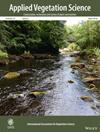Capybaras (Hydrochoerus hydrochaeris) Generate Grazing Lawns and Maintain Plant Diversity in Neotropical Savanna
Abstract
Questions
Herbivores can exert strong top-down control on vegetation structure and composition, which in turn can affect overall biodiversity and ecosystem processes. However, South American megafauna was largely driven to extinction in recent prehistory, and remaining species have suffered severe range reductions from human actions. The potential role of South American megafauna in shaping vegetation therefore remains unclear. We examined herbivore-driven top-down control of the vegetation, particularly impacts on plant diversity, structure and functional composition.
Location
Iberá Wetlands, Corrientes, Argentina.
Methods
We set up an herbivore exclosure experiment in a restoration area with 10 wild large-herbivore species. We compared vegetation dynamics in fenced plots with paired control plots to which herbivores had full access. Replicate plot pairs were established in three grassland types: characterized as short, medium-tall and tall grasslands. Grass height, plant biomass, functional types and community composition were measured at the start of the experiment and after 6, 13 and 18 months.
Results
We found that in short and medium-tall grasslands, herbaceous biomass and grass height increased significantly in no-grazing plots, while species richness decreased. Similarly, community dissimilarity between paired grazed and ungrazed plots increased over time for short and medium-tall grasslands. Camera trap images revealed that capybara (Hydrochoerus hydrochaeris) was the dominant grazer on the grazed plots.
Conclusion
Our results show a strong impact of native herbivores on the structure and composition of South American savannas akin to African grazing lawns, with higher plant species richness and dominance of grazing-tolerant growth forms. These results imply that South American grassy ecosystems, despite severely reduced herbivore richness and density, have retained plant taxa and functional trait complexes that tolerate intense herbivory. Further, they also show that herbivory can still play an important role in maintaining their plant diversity. The conservation and restoration of South American grassy ecosystems are likely to benefit from restoring functional grazing regimes.


 求助内容:
求助内容: 应助结果提醒方式:
应助结果提醒方式:


